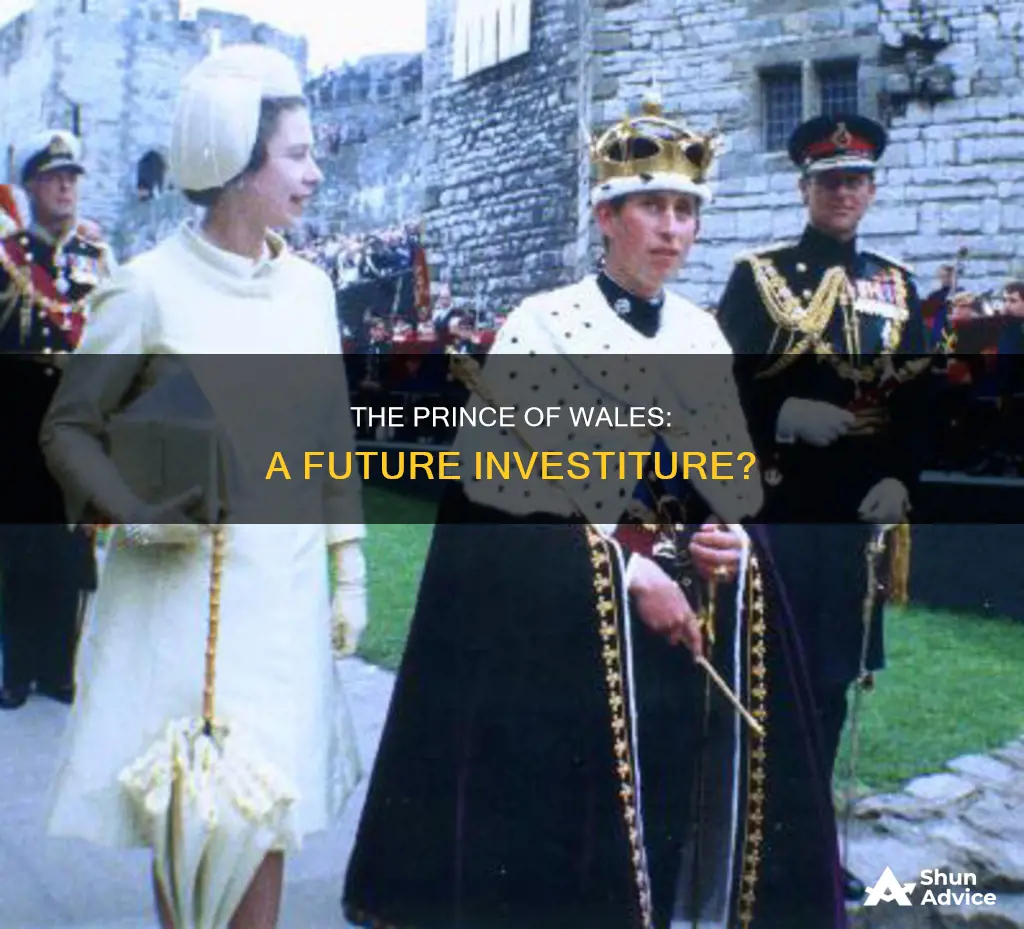
The Prince of Wales title is usually given to the heir apparent of the English or British throne. While the ceremony was last held in 1969 for Queen Elizabeth II's eldest son, King Charles III, there are no plans for a similar ceremony for the current Prince of Wales, William. This decision is influenced by controversy surrounding the title in Wales and a desire to deepen the trust and respect of the people of Wales instead.
| Characteristics | Values |
|---|---|
| Current Prince of Wales | William |
| Date of Appointment | 9 September 2022 |
| Plans for Investiture | No plans for an investiture |
| Reasoning | Controversy around the title in Wales |
| Reasoning | Focus on deepening trust and respect of the people of Wales |
| Reasoning | Cost of living crisis |
| Reasoning | Political controversy surrounding the 1969 investiture of Charles |
| Reasoning | A desire to break with tradition |
| Reasoning | Aware of the historical sensitivities |
What You'll Learn
- Prince William has no plans for an investiture ceremony
- The decision is influenced by the cost-of-living crisis and the desire to ensure the monarchy remains relatable
- There is controversy surrounding the title of Prince of Wales, with some calling for an end to its use
- The last investiture ceremony for the Prince of Wales took place in 1969 for King Charles III
- The ceremony included the presentation of the sword, coronet, ring, rod, and mantle

Prince William has no plans for an investiture ceremony
Prince William, the current Prince of Wales, has no plans for an investiture ceremony. This was confirmed by Kensington Palace during his first visit to the Welsh Parliament since his father, King Charles III, gave him the title. The King's decision sparked a debate about whether there should be a repeat of the 1969 ceremony that invested Charles as the Prince of Wales.
The investiture ceremony for the then-Prince Charles took place at Caernarfon Castle in 1969. It was a grand affair with 4,000 guests in attendance, and millions more watching on television across the world. The ceremony presented Charles with the symbols of his new role: the sword, coronet, ring, rod, and mantle. While the event was celebrated by some, it also faced protests and bombings.
William, on the other hand, has chosen to focus on "deepening the trust and respect of the people of Wales" rather than holding a formal investiture ceremony. This decision is partly due to the controversy surrounding the title of Prince of Wales in Wales, with some organisations and individuals calling for an end to the use of the title. Additionally, with the UK facing a cost-of-living crisis, forgoing a lavish ceremony is seen as a way to ensure the monarchy remains relatable and relevant to the people.
During his visit to Wales, William met with presiding officer Elin Jones and deputy presiding officer David Rees. He also met with politicians from the four parties represented in the Senedd: Welsh Labour, the Welsh Conservatives, Plaid Cymru, and the Welsh Liberal Democrats. William expressed his desire to deepen his understanding of the issues and opportunities that matter most to the Welsh people. He also addressed the controversy surrounding his support for the English football team, stating that he would be supporting both England and Wales in the World Cup.
While there may not be a formal investiture ceremony, William is committed to building a strong relationship with Wales and its people.
Dave Ramsey's Investment Advice: Right or Wrong?
You may want to see also

The decision is influenced by the cost-of-living crisis and the desire to ensure the monarchy remains relatable
The decision to not hold a formal investiture ceremony for the Prince of Wales is influenced by the ongoing cost-of-living crisis and the monarchy's desire to remain relatable to the people of Wales and the United Kingdom.
The investiture of the Prince of Wales is a ceremonial tradition that dates back to 1301, when King Edward I bestowed the title to his heir apparent, Edward of Caernarfon. The ceremony typically involves presenting the prince with the insignia of his rank and dignity, similar to a coronation. However, in the case of the current Prince of Wales, William, there are no plans for a formal investiture ceremony.
Instead, William and his wife, Kate, are focused on "deepening the trust and respect of the people of Wales." This decision comes amidst a cost-of-living crisis in the United Kingdom, where people are struggling with rising costs of utilities and food, flatlining wages, and increasing poverty and homelessness. Holding a lavish and expensive investiture ceremony during such challenging times could be seen as tone-deaf and out of touch with the struggles of the British people.
By forgoing the formal investiture, the monarchy aims to remain relatable and relevant to the public. This decision is also in line with the sentiment expressed by First Minister Mark Drakeford, who stated it is "easy to see" why a different approach is being taken "during tough times."
Furthermore, the decision not to hold a grand investiture is also influenced by the controversy surrounding the previous investiture of Charles III in 1969. The event faced protests and criticism, and similar opposition has been expressed towards the title of Prince of Wales itself. By avoiding a formal ceremony, the monarchy aims to navigate these political sensitivities and focus on building a positive relationship with the people of Wales.
While there will not be a formal investiture, William and Kate have already made visits to Wales, including Anglesey and Swansea, to meet with the community and express their deep affection for the country. They plan to continue spending time in Wales and strengthening their relationship with its people.
Retirement Investments: Living Off Profits
You may want to see also

There is controversy surrounding the title of Prince of Wales, with some calling for an end to its use
The history of Wales's relationship with England helps explain the strong opinions surrounding the title. The last native prince of an independent Wales, Llywelyn the Last, was killed by English soldiers in 1282 during a war in which Wales fought for its national identity and resisted the imposition of English law. Following Llywelyn's death, King Edward I declared his son, later Edward II, the first non-native Prince of Wales to assert English sovereignty. This began the tradition of granting the title to the heir apparent to the English throne.
Many in Wales view the title as a symbol of historical invasion and oppression, and a reminder that they are "owned by the regime rather than citizens of their country." They argue that the title has "been held exclusively by Englishmen as a symbol of dominance over Wales" and that those holding the title have no genuine connection to Wales. Additionally, critics point out that the title has no constitutional role in Wales, which is now a devolved country with its own national Parliament.
The decision to grant William the title has been met with mixed reactions. While a YouGov poll showed that 66% supported Prince William being given the title, petitions calling for its abolition have gathered tens of thousands of signatures. Gwynedd council in north Wales has also voted to express its opposition to the title and has asked for a consultation on whether it should be abolished.
The contemporary debate is not solely focused on abolition but also explores how the title might be adapted to reflect the changing constitutional relationship with Wales. This includes questioning whether the Welsh Government should play a greater role in the appointments process or whether there should be a Senedd ceremonial process to reflect the nation's governance over its affairs.
Investments: What's the Return?
You may want to see also

The last investiture ceremony for the Prince of Wales took place in 1969 for King Charles III
The investiture ceremony is a tradition that began in 1301 when King Edward I gave the title to his heir apparent, Edward of Caernarfon. The title is usually given to the heir apparent of the English or British throne. The ceremony is ceremonial, as the title is formally conferred via letters patent issued by the monarch.
In preparation for the ceremony, Prince Charles spent ten weeks at the University College of Wales in Aberystwyth, where he learned about Welsh culture, history, and language. During the ceremony, he gave his address in Welsh and his replies in both Welsh and English. He also pledged his allegiance to the Queen, saying:
> "I, Charles, Prince of Wales, do become your liege man of life and limb and of earthly worship, and faith and truth I will bear unto thee, to live and die against all manner of folks."
The event was televised and watched by 19 million people in Britain and 500 million worldwide. It was largely welcomed by the people of Wales, but it also faced protests.
Since the 1969 investiture, the title has been passed down to Prince William, the current Prince of Wales and son of King Charles III. However, there are no plans for a formal investiture ceremony for Prince William, with the focus instead on "deepening the trust and respect of the people of Wales."
Rich People: Where's the Money?
You may want to see also

The ceremony included the presentation of the sword, coronet, ring, rod, and mantle
The Prince of Wales title is usually given to the heir apparent of the English or British throne. The ceremony was last held in 1969 for Queen Elizabeth II's eldest son, Charles, who became King in 2022. His son, William, became the current Prince of Wales in 2022, but there are no plans for a formal investiture.
The investiture ceremony is rich in symbolism and involves the presentation of several items of insignia to the new Prince of Wales. These include the sword, coronet, ring, rod, and mantle.
The sword is a ceremonial weapon with a silver-gilt hilt formed as a coronet supported by two Welsh dragons above the motto "Ich Dien". The dragons' tails form the grip and separate to create the guard. The hilt is inscribed with the name of its designer, W. Goscombe John, and the date of its creation, 1911. The blade is etched with a coronet and the monogram "E", as well as the motto "Ich Dien" on one face and the Prince of Wales feathers and "IORWERTH:TYWYSOG:CYMRV:M.G" on the reverse. The sword is accompanied by a velvet-covered scabbard and belt.
The coronet is a circular, crown-like headpiece. The coronet and mantle, a cloak made of luxurious fabric, were both made specifically for the 1969 investiture ceremony of Prince Charles.
The ring is made of gold, as is the rod, which is also known as a sceptre, a type of ceremonial staff.
These items of insignia were also used in the investiture of the future King Edward VIII in 1911.
Retirement Plans: Exploring the Investment Angle
You may want to see also
Frequently asked questions
No, the Prince of Wales has no plans for an investiture.
The Prince of Wales is aware of the political controversy that surrounded the event in 1969 and does not want to stoke controversy with a lavish or arcane investiture.
The tradition of investing the heir apparent of the English, and subsequently the British, monarch with the title of "Prince of Wales" began in 1301 when King Edward I gave the title to his heir apparent, Edward of Caernarfon. The ceremony was last held in 1969 for Queen Elizabeth II's eldest son and heir apparent, Charles III.







